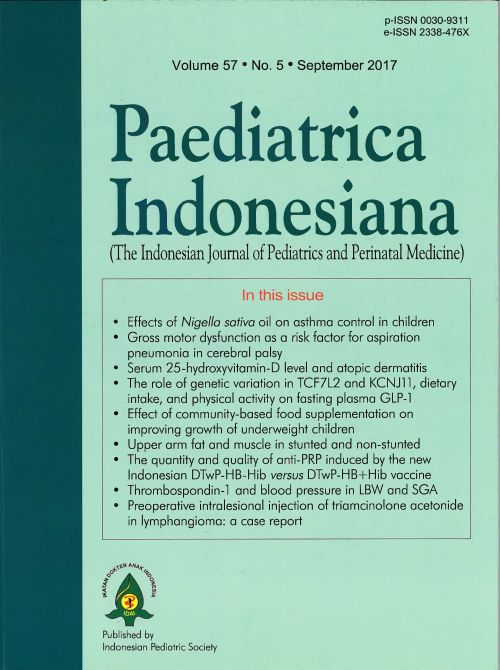Effect of community-based food supplementation on improving growth of underweight children under five years of age in West Nusa Tenggara
Abstract
Background The prevalence of underweight children in West Nusa Tenggara is as high as 30%. This region had the third largest number of stunted children in the country. The local government has attempted to tackle this problem by providing supplementary food to underweight children.
Objective To assess the success of the community-based food supplementation program onimproving children’s growth in West Nusa Tenggara.
Methods We conducted a prospective cohort study for 10 months in Paruga District Primary Health Care Unit, Bima, West Nusa Tenggara, in year 2012. Children were given supplementary food according to the Ministry of Health’s guidelines, consisting of formula milk, high calorie biscuits, and a 60-day supply of eggs, estimated to be sufficient to normalize their weights, for their age and sex.  A child’s weight and height were measured every 3 months and the results plotted on WHO growth charts for weight-for-age, height-for-age, and weight-for-height (nutritional status). Z-score <-3 SD was classified as severely underweight, severely stunted, or severely wasted, respectively; Z-score between -2 and -3 SD was classified as underweight, stunted, or wasted, respectively; and Z–score >-2 SD was classified as normal for all three categories.
Results Twenty-five children under five years of age participated in this study. Subjects’ median age was 29 months. None of the subjects had normal weight-for-age Z-score at the beginning of the study. Eighty-four percent (21/25) of the subjects were severely underweight. Only 8% (2/25) of the subjects had normal height-for-age Z-score and 88% (22/25) of them were severely stunted. However, 80% (20/25) of subjects had normal nutritional status (weight-for-height). Changes in weight-for-age Z-score varied throughout the study. The highest median score was in the tenth month of follow up (-3.82). The highest median height-for-age score and weight-for-height score were also in the last month of follow up. At the end of the study, only one subject had normal weight-for-age score (4%) and none of the subjects had normal height-for-age scores. Â
Conclusion The 10-month supplementary food program for under-five children in the Paruga District is not successful in improving body weight and height.
References
2. UNICEF. Improving child nutrition: the achievable imperative for global progress. New York: UNICEF; 2013. p. 1-114.
3. Inter-Agency and Expert Group on SDG Indicators (IAEG-SDGs). Final list of proposed Sustainable Development Goal indicators. Report number : E/CN.3/2016/2/Rev.1. 2016. p. 3.
4. Basic Health Research (Riset Kesehatan Dasar) 2013. Jakarta: Kementerian Kesehatan RI; 2013. p 212-3.
5. Adair LS, Fall CH, Osmond C, Stein AD, Martorell R, Ramirez-Zea M, et al. Associations of linear growth and relative weight gain during early life with adult health and human capital in countries of low and middle income: findings from five birth cohort studies. Lancet. 2013; 382: 525-34.
6. Cohen P, Rogol AD, Deal CL, Saenger P, Reiter EO, Ross JL, et al. Consensus statement on the diagnosis and treatment of children with idiopathic short stature: a summary of the Growth Hormone Research Society, the Lawson Wilkins Pediatric Endocrine Society, and the European Society for Paediatric Endocrinology Workshop. J Clin Endocrinol Metab. 2008 ;93: 4210-7.
7. Grantham-McGregor S, Cheung YB, Cueto S, Glewwe P, Richter L, Strupp B, et al. Developmental potential in the first 5 years for children in developing countries. Lancet. 2007; 369: 60-70.
8. Alderman H, Ndiaye B, Linnemayr S, Ka A, Roxk C, et al. Effectiveness of a community-based intervention to improve nutrition in young children in Senegal: a difference in difference analysis. Public Health Nutrition. 2008; 12: 667–73.
9. Waterlow JC, Schurch B. Causes and mechanisms of linear growth retardation. Eur J Clin Nutr. 1994; 48: S1-S216.
10. Li H, Stein AD, Barnhart HX, Ramakhrishnan U, Martorell R. Associations between prenatal and postnatal growth and adult body size composition. Am J Clin Nutr. 2003; 77: 1498-505.
11. Dewey KG, Adu-Afarwuah S. Systematic review of the efficacy and effeciveness of complimentary feeding interventions in developing countries. Matern Child Nutr. 2008; 4: 24-85.
12. Ruel MT, Alderman H, The Maternal and Child Nutrition Study Group. Nutrition-sensitive interventions and programmes: how can they help to accelerate progress in improving maternal and child nutrition? Lancet. 2013; 382: 536-51.
13. Bhutta ZA, Ahmed T, Black RE, Cousens S, Dewey K, Giugliani E, et al. What works? Interventions for maternal and child undernutrition and survival. Lancet. 2008; 371:417-40.
Authors who publish with this journal agree to the following terms:
Authors retain copyright and grant the journal right of first publication with the work simultaneously licensed under a Creative Commons Attribution License that allows others to share the work with an acknowledgement of the work's authorship and initial publication in this journal.
Authors are able to enter into separate, additional contractual arrangements for the non-exclusive distribution of the journal's published version of the work (e.g., post it to an institutional repository or publish it in a book), with an acknowledgement of its initial publication in this journal.
Accepted 2017-10-16
Published 2018-01-05













